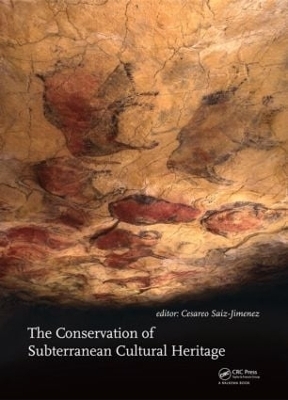
The Conservation of Subterranean Cultural Heritage
CRC Press (Verlag)
978-1-138-02694-0 (ISBN)
This proceedings volume contains selected papers presented at the International Workshop "The Conservation of Subterranean Cultural Heritage", held 25-27 March 2014, in Seville, Spain. The workshop was organized by the Spanish Network of Science and Technology for the Conservation of Cultural Heritage (TechnoHeritage). The objective of the workshop was to promote an interdisciplinary forum for discussion of all aspects of the conservation of subterranean cultural heritage, providing at the same time an up-to-date, comprehensive overview of the most recent investigations.
This book covers a wide range of scientific dimensions of the conservation and management of caves and necropolises. This state-of-the-art book will be of particular interest to archaeologists, historians, conservationists, cultural heritage specialists, architects, engineers and local and governmental policy-makers. Richly illustrated and including a 16-page full-colour plate section.
Cesareo Saiz-Jimenez is a Research Professor at the Institute for Natural Resources and Agricultural Biology, Spanish National Research Council, Seville, Spain. He holds a Ph.D. in Biology (1975) from the University of Madrid, Spain, and in Chemical Engineering and Materials Sciences (1987) from the Technical University of Delft, The Netherlands. Since 1987 he has received funding from the European Commission, in Environment Research Programmes (1986-1994), Environment and Climate (1995-1998), The City of Tomorrow (1999-2002), and the 6FP and 7FP (2003-2013) as well as from national research programmes. He has participated in a total of 22 European projects and was national coordinator of EUROCARE (EUREKA programme), and Spanish manager of the City of Tomorrow and the Cultural Heritage, Key Action 4 from the European Commission. He is the current coordinator of the Spanish Network for Science and Technology for the Conservation of Cultural Heritage. This network comprises over 90 teams from universities, research centres, museums and SMEs. He has written over 450 papers published in international journals, congresses and workshops, as well as edited a number of books on different topics. Most of his research activity is aimed at the study of microbial communities in different terrestrial and aquatic ecosystems, biogeochemistry of terrestrial environments, and effects of air pollution on building materials. Particular attention was devoted to cultural heritage deterioration processes by microorganisms. In the last 20 years he has focused his research on the microbiology of subterranean environments (caves, ancient tombs, catacombs, mines). Papers issuing from this research describe e.g. the microbial ecology of caves such as Altamira in Spain, Lascaux in France and Grotta dei Cervi in Italy, microbe-mineral interactions, the biogeochemical cycle of elements, and the biodeterioration of rock art and mural paintings.
The Conservation of Subterranean Cultural Heritage: Is it a technical problem or a political problem?; The rock-cut tomb-chapels of Hery and Djehuty on the West Bank of Luxor; chapter 3: Excavations and conservation problems in the Roman Necropolis along Via Triumphalis in the Vatican; Problems of colour preservation in the Etruscan necropolises of Tuscany (Italy): The painted tombs of Chiusi (Siena) and Sovana, Sorano (Grosseto); A study for monitoring and conservation in the Roman Catacombs of St. Callistus and Domitilla, Rome (Italy); The conservation of the Carmona Necropolis (Sevilla, Spain); Methodological approach to monitor Roman Catacombs: Experience in the Catacombs of St. Mark, Marcellian and Damasus, Rome, Italy; Identification of lime-based mural painting techniques in catacombs using well-established criteria of stratigraphic investigation; New species description, biomineralization processes and biocleaning applications of Roman catacombs-living bacteria; The mural execution technique of the “dei Fornai” cubicle revealed by laser cleaning; Indoors diversity in phototrophic biofilms at St. Paul?s Catacombs (Malta); Detection of urban subsurface pollution by rapid multiparametric surveys in the 16th century Paranhos spring water tunnel (Porto, Portugal); Is the presence of bacterial communities related to the urban contamination sources of the 16th century Paranhos spring water tunnel?; Microbe-mineral interactions at a Portuguese geo-archaeological site; “La vie en rose”: A review of the rosy discoloration of subsurface monuments; NanoGraphene Oxide: A new material for a non-invasive and non-destructive strategy to remove biofilms from rock surfaces; Round table on conservation of necropolises, catacombs and tombs; Microclimatic monitoring in Altamira Cave: Two decadesof scientific projects for its conservation; Altamira and its future; The conservation of Lascaux Cave, France; The conservation of Chauvet Cave, France. The conservation, research organization and the diffusion of knowledge of a cave inaccessible to the public; The conservation of prehistoric caves in Cantabria, Spain; The conservation of the Nerja Cave: Preserving anthropogenic impact in a tourist cave; Cueva del Tesoro, Rincón de la Victoria, Málaga: A treasure of biodiversity; Contribution of culture-independent methods to cave aerobiology: The case of Lascaux Cave; Are fungi a real threat for the conservation of Altamira Cave?; Pathogenic microorganisms related to human visits in Altamira Cave, Spain; Microscopic fungi isolated from cave air and sediments in the Nerja Cave—preliminary results; Human impact on show caves: Chewing gum stuck to the walls; Lampenflora as an accompaniment of mass cave tourism, problems and solutions for Postojnska jama, Slovenia; Microorganisms and the natural heritage of Dinaric karst—a review; Needle-fiber calcite in Kapova Cave (the Southern Urals, Russia): Influence on Upper Paleolithic wall paintings and genesis problems; Raman Microscopy and IR Imaging of the Palaeolithic Paintings from Kapova Cave, Southern Ural, Russia; Applications of Raman and Infrared spectroscopies to the research and conservation of subterranean cultural heritage; Round table on conservation of caves
| Verlagsort | London |
|---|---|
| Sprache | englisch |
| Maße | 174 x 246 mm |
| Gewicht | 725 g |
| Themenwelt | Kunst / Musik / Theater |
| Reisen ► Reiseführer | |
| Geisteswissenschaften ► Archäologie | |
| Geisteswissenschaften ► Geschichte ► Hilfswissenschaften | |
| Technik ► Bauwesen | |
| Technik ► Maschinenbau | |
| Technik ► Umwelttechnik / Biotechnologie | |
| ISBN-10 | 1-138-02694-8 / 1138026948 |
| ISBN-13 | 978-1-138-02694-0 / 9781138026940 |
| Zustand | Neuware |
| Haben Sie eine Frage zum Produkt? |
aus dem Bereich


